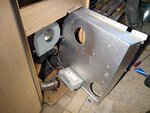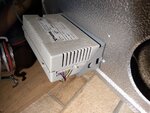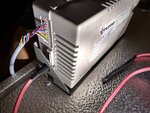I recently tackled the overhaul of my Trumatic s3002 Gas Heater with Ultraheat Electric Heater, a horrible job because of poor accessibility. I acknowledge the expertise of Gary of
www.arcsystems.biz, without whose notes on this forum I wouldn't have known where to start.
I attach the following notes and photos from my experience and prior research which might assist others. My caravan is a 2001 Elddis Avante 482.
OVERHAUL OF TRUMATIC S3002 GAS HEATER WITH ULTRAHEAT ELECTRIC ADDITION
Isolate gas, and 12v and 230v supplies.
Remove the fire front by pulling the top forward till it releases, then pulling upwards. The gas temperature control knob pulls upwards to remove, and the electrical connections pull off.
Fire front removal and replacement is clarified in this video:
View: https://www.youtube.com/watch?v=yPIui6wAQNU&app=desktop
Unfortunately the retaining springs get bent and don't hold the front securely. Owners often put small screws through the top to hold it in place (I had previously done this).
Disconnect the gas fire flue (retaining ring has 1 screw). The 53mm diameter rubber seal (10030-26500) should be discarded. It must be replaced with a brand new one on re-assembly - otherwise poisonous carbon monoxide could leak into the van when the gas heater is used.
Disconnect the gas pipe underneath the caravan. Remove the complete s3002 gas heater after removing 5 large wood screws that secure it to the floor. The gas fire is not attached to the dimpled sheet metal backing (the ‘Installation Box 30040-16800’). Only the Ultraheat electrical items are mounted on the Installation Box.
Reaching behind the Installation Box, remove the fan motor assembly. It is fixed by 3 self-tapping screws to the Installation Box. The fan motor assembly has open-ended slots for the screws, so it is theoretically possible to loosen the screws and rotate the body slightly to remove it, like a bayonette light bulb. However, if it is too difficult to do this in practice, the screws will have to be removed. No need to remove the ducting from fan the motor assembly.
Now the installation box, complete with Ultraheat electric element and printed circuit box, can be removed after unscrewing about 7 tiny woodscrews.
Check the heating element is securely attached to the backing plate with all 4 fastening plates (30030-95700).
Check the warm air ducts are connected properly to the fan motor assembly without air leaks. There should be two self-tapping retaining screws retaining each duct. Take the opportunity of cleaning any dust off the fan blades.
If appropriate, seal up any gaps that would allow draughts from the adjacent fridge enclosure to affect the back of the heater. The heater should get its air input via the 40 mm gap at the bottom of the fire front, not from the fridge enclosure. (However, obviously, combustion air for the gas burner comes from under the floor, with flue gas exhausted to the roof cowl.)
Plug the jack of a remote electrical temperature sensor 30030-7100 into the Ultraheat printed circuit board in its plastic box. On reassembly, attach the sensor end of the wire to the gas temperature sensor using two cable ties.
If necessary, replace both the 125C temperature control device (30030-65100) and the 175C temperature limiter (30030-65200) if they are thought to be faulty.
Rebuild, using LPG jointing compound on the gas connection. When replacing the fire front, make sure the earthing spring makes good contact. A useful modification is to add a proper earthing wire between the body of the gas fire and the fire front, making the earthing spring redundant and ensuring a good spark from the gas igniter.
To ensure safety compliance, get the gas and electrical systems tested by qualified persons before switching on and testing.









